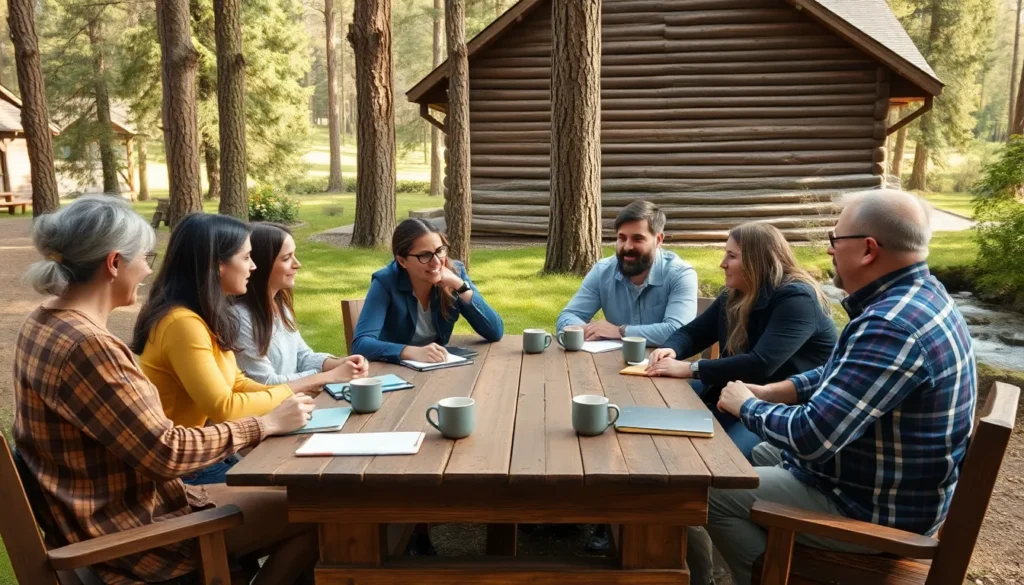Table of Contents
TogglePlanning a partner retreat can feel like herding cats, but it doesn’t have to be a circus act. Whether it’s to strengthen relationships or brainstorm the next big idea, a successful retreat can transform the way teams collaborate. Picture this: a cozy cabin in the woods, laughter echoing off the trees, and a whiteboard filled with brilliant ideas. Sounds dreamy, right?
Importance Of Partner Retreats
Partner retreats serve as essential opportunities for strengthening relationships within a team. They promote collaboration by creating an environment where team members can connect outside their usual work settings. Enhancing communication occurs naturally in relaxed atmospheres, which allows participants to express ideas freely.
Building trust among team members significantly benefits from retreat activities. When individuals spend quality time together, they develop deeper interpersonal connections. Retreats encourage diverse perspectives, leading to innovative solutions for business challenges.
Facilitating open dialogue occurs more easily in a retreat setting. Engaging in focused discussions can produce valuable insights and strengthen unity among team members. Additionally, these retreats offer a chance to identify shared goals and align objectives, increasing overall productivity.
Establishing a creative atmosphere fosters brainstorming and problem-solving. Structured activities can stimulate creativity while allowing organic conversations to flow. Unconventional settings often lead to breakthrough ideas that may not arise in regular meetings.
Rejuvenating team spirit is another significant aspect of partner retreats. Participants often return to work invigorated, ready to tackle challenges collaboratively. This renewed energy can translate into improved morale and enhanced team performance.
Tracking the benefits of partner retreats highlights their lasting impact. Research indicates that organizations investing in team-building activities experience higher employee satisfaction and lower turnover rates. Prioritizing these retreats can be a vital strategy for long-term success and growth within any partnership.
Planning Your Partner Retreat

Planning a successful partner retreat involves setting clear intents and choosing an optimal setting. Attention to these areas improves overall experience.
Setting Objectives
Establishing clear objectives guides the retreat’s focus, ensuring all activities align with team goals. Participants benefit from defined purposes, such as enhancing communication or brainstorming innovative strategies. Identifying key outcomes helps keep discussions productive and focused. Setting specific, measurable goals enables teams to assess success after the retreat. Consider engaging partners in this process, as their perspectives contribute valuable insights and foster ownership of the retreat’s objectives.
Choosing The Right Location
Selecting an appropriate venue sets the tone for the retreat. Favor locations that inspire creativity and encourage collaboration. Natural settings, such as cabins or beachfront properties, provide relaxed backdrops for open dialogue. Accessibility remains crucial; venues should accommodate all participants comfortably. Additionally, consider facilities for both group activities and private meetings. Evaluate logistical aspects like accommodations, catering, and technology support to ensure a smooth experience. A thoughtfully chosen location enhances team bonding and creates lasting memories.
Activities To Consider
Engaging activities are crucial for a successful partner retreat, as they foster interaction and collaboration among team members.
Communication Exercises
Communication exercises enhance understanding and trust within teams. Activities like active listening drills promote empathy and awareness. Role-playing scenarios allow participants to express perspectives and devise solutions collaboratively. Engaging in group discussions helps clarify objectives and encourages open dialogue. These exercises empower teams to navigate challenges more effectively, creating a stronger bond among members.
Fun Team-Building Activities
Fun team-building activities boost morale and strengthen connections among participants. Options like scavenger hunts encourage teamwork and strategic thinking. Creative workshops, such as painting or cooking classes, foster collaboration while allowing self-expression. Outdoor challenges, like obstacle courses, promote camaraderie and a sense of accomplishment. Incorporating light-hearted competitions, such as trivia games, can spark excitement and engagement. Each activity cultivates a positive atmosphere that supports relationship-building within the team.
Creating A Productive Environment
A productive environment ensures an effective partner retreat. Establishing the right atmosphere enhances collaboration and creativity.
Setting Up The Space
Arrange comfortable seating to encourage openness. Utilize natural lighting to boost mood and energy levels. Incorporate various breakout areas for discussion and brainstorming sessions. Personalize the space with inspirational quotes and visuals to foster creativity. Consider providing necessary materials like markers, notepads, and whiteboards to facilitate engagement. Create a welcoming ambiance with refreshments available throughout the retreat. These elements contribute to a space that inspires active participation.
Timing And Schedule
Implementing a well-structured agenda maximizes productivity. Allocate specific times for discussions, activities, and breaks to maintain focus. Create flexibility in the schedule to adapt to team dynamics and emerging ideas. Strategically timing difficult conversations can enhance outcomes. Include ample breaks to recharge energy and encourage informal interactions. Designate evenings for team bonding activities, strengthening relationships further. These considerations help maintain momentum and engagement throughout the retreat.
A well-planned partner retreat can be a transformative experience for any team. By prioritizing clear objectives and choosing an inspiring location, organizations can create an environment that fosters collaboration and creativity. Engaging activities and a thoughtfully structured agenda ensure that team members connect on a deeper level, enhancing trust and communication.
Investing in such retreats not only boosts morale but also leads to greater employee satisfaction and retention. When teams return invigorated and aligned with shared goals, they’re better equipped to tackle challenges and drive success. Ultimately, a partner retreat is more than just a getaway; it’s a strategic investment in the future of the partnership.




